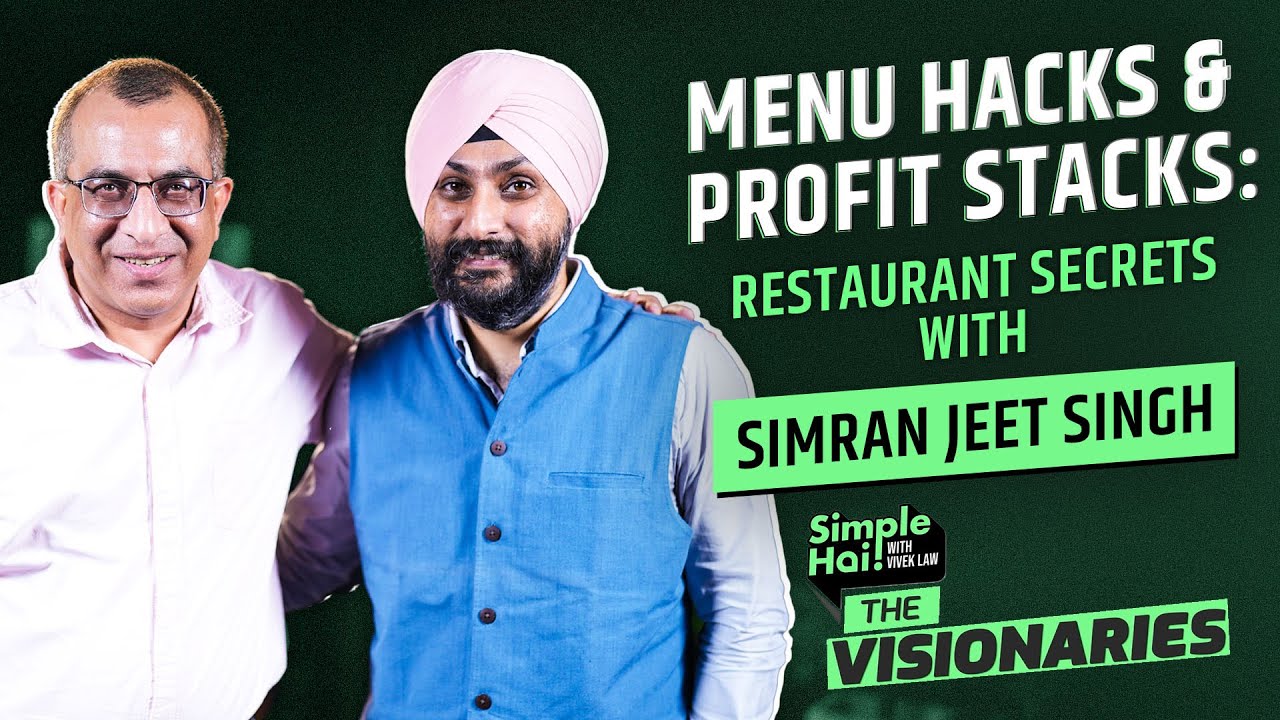
India’s food and beverage (F&B) industry is booming in popularity but unforgiving in practice. According to Simran Jeet Singh, founder of CYK Hospitalities, an alarming 72% of new restaurants in India shut down within a short span of time. With over 12 years of hands-on experience, Singh shared valuable insights on Simple Hai!, debunking myths, highlighting trends, and offering practical advice for aspiring restaurateurs.
The Harsh Reality of the Restaurant Business
One of the key points Singh emphasized was the widespread misconception that opening a restaurant is easy. Many people enter the F&B space driven by their passion for food but neglect the strategic planning needed to sustain the business.
A common mistake is to lock down a property first and then decide on the concept or cuisine. This approach often leads to misaligned offerings that fail to connect with the target audience. According to Singh, successful restaurants are built by engineering a concept around consumer needs—not the other way around. And at the heart of any such concept lies the most important ingredient: the food itself.
CYK Hospitalities: Filling the Industry’s Knowledge Gap
CYK Hospitalities was born out of necessity. Simran Jeet Singh and his business partner Pulkit Arora—both engineers with corporate backgrounds—entered the F&B world somewhat accidentally. Pulkit had launched a food brand, and Simran joined him in scaling it.
While expanding, they identified a glaring gap in the market: the absence of specialized consultants for restaurant planning and kitchen design. They decided to bridge that gap themselves, eventually creating CYK Hospitalities, which is now India’s only comprehensive F&B consultancy.
From brand concept to kitchen layout, CYK offers end-to-end services across seven to eight verticals. The company has helped set up restaurants not only across India but also in international markets like Dubai, Sri Lanka, and Canada, often for Indian brands expanding abroad.
Menu Engineering: The Secret Sauce to Success
One of the most underappreciated aspects of restaurant planning, according to Singh, is menu engineering. While it might sound simple, it’s a deeply analytical process that requires understanding market needs, pricing dynamics, and customer behavior.
“You can sell a pizza for ₹150 or ₹1500, depending on the audience and the experience you create,” Singh explained. The process involves identifying the target demographic, studying their preferences, testing products, and only then finalizing the menu. This also determines the restaurant’s ambiance, location, and even branding.
A menu should never be copied from other successful outlets. Each food concept must be uniquely tailored to its specific market and customer.
Trends Shaping the Indian F&B Landscape
India’s culinary scene is evolving rapidly. Singh noted several key trends reshaping the industry:
- Diverse Indian Cuisine: With regional flavors changing every 10–20 kilometers, there’s a vast untapped opportunity to showcase authentic Indian cuisines in modern formats.
- Impact of Global Travel: Increased travel has made Indian consumers more adventurous. International cuisines like Lebanese, Mexican, and Japanese are gaining popularity domestically. Conversely, Indian food is also making waves globally.
- Modernizing Tradition: Many restaurants are now bringing village or city-specific dishes into contemporary settings with enhanced presentation and dining experiences.
- Cloud Kitchens vs. Dine-in: While cloud kitchens surged during the COVID-19 pandemic, dine-in formats have made a strong comeback post-pandemic. According to the National Restaurant Association of India (NRAI), dine-in business is currently thriving—driven by the human need for connection and experience.
- Focused Branding: Successful food businesses don’t try to please everyone. Whether it’s a QSR (Quick Service Restaurant), fine dining spot, or lounge, clarity on the target audience is essential. Singh pointed out that brands like McDonald’s succeed because they know exactly whom they serve and stay consistent.
- Rise of the Celebrity Chef: The last two decades have seen chefs achieving celebrity status. While this helps with brand visibility, it also sets high customer expectations, which not every outlet can meet. Many celebrity chefs are now also stepping into consulting roles.
- Consistent Growth: Unlike the retail industry, which faced dips during COVID, the food sector continued to grow. Year-on-year, the F&B industry in India is expanding steadily.
Advice for Aspiring Food Entrepreneurs
For young entrepreneurs dreaming of opening a restaurant, Singh’s advice was grounded and clear: honesty and dedication are non-negotiable.
“You need to ask yourself: who will run the show?” he stressed. Passive investment rarely works in the F&B space. Whether it’s the first outlet or a franchise, hands-on involvement for at least 6–12 months is crucial. Without this commitment, failure is almost guaranteed.
The first outlet should be treated as a pure R&D phase—a testing ground for everything from food to service to customer feedback. It often comes with high costs, but if done right, it paves the way for scalable expansion.
At CYK Hospitalities, clients are vetted carefully. Singh and his team onboard only those who understand the realities of the industry and are prepared to put in the hard work. “From shop to brand” is a journey that takes patience, honesty, and resilience.
Final Thoughts
The food business in India may be fiercely competitive and fraught with risks, but with the right planning, strategy, and dedication, success is achievable. As Singh’s journey shows, professional insight, clarity of concept, and a customer-first approach are essential to surviving—and thriving—in this high-stakes industry.
For those who dream of opening their own restaurant, Singh’s message from Simple Hai! is both a warning and a motivation: it’s not easy, but it’s worth it—if you do it right.
Leave a Reply